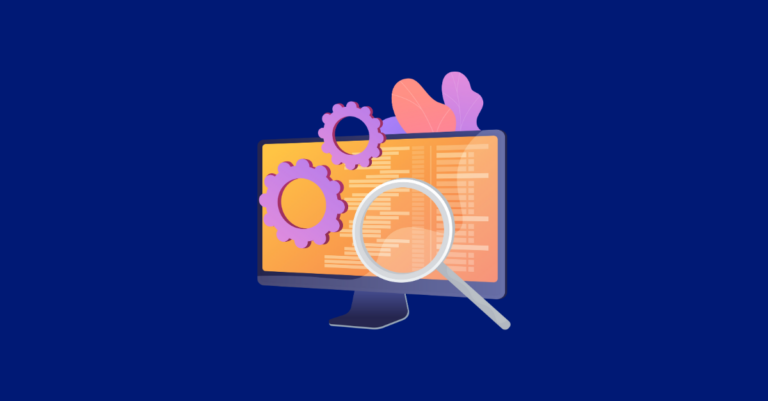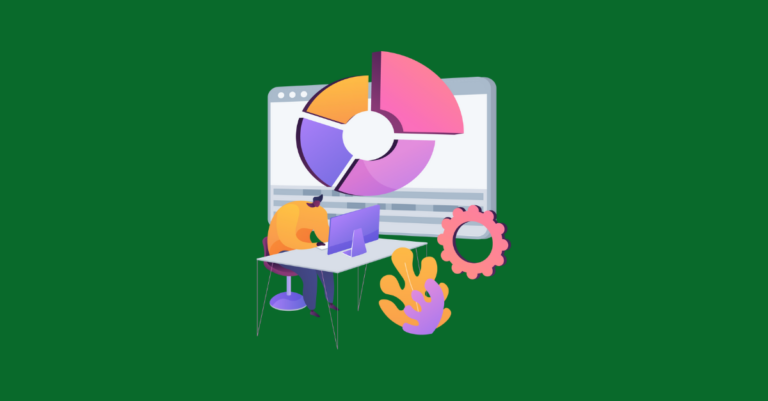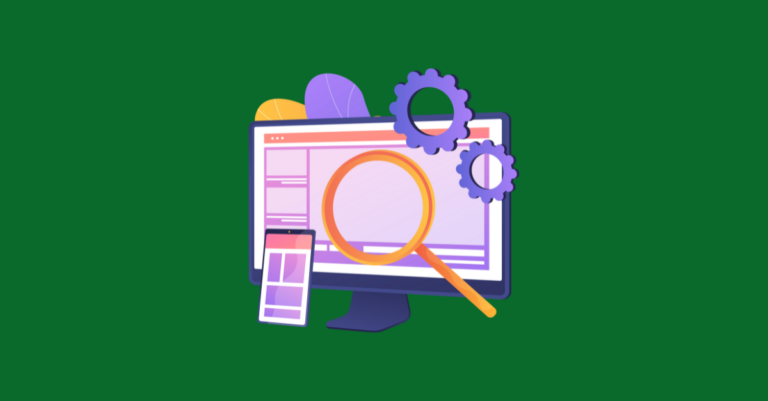What Is User Intent in SEO? Aligning Content for Stronger Rankings, Engagement & Conversions
Understanding query intent is one of the most crucial elements of ranking well on Google. If you misinterpret it, your chances of ranking for specific target keywords drop significantly.
Google determines rankings partly based on the searcher’s query. Since the Hummingbird Update in 2013, Google’s algorithm has incorporated semantic search models to understand the intent behind every search better. This means Google started considering context, synonyms, and word relationships to determine the user’s intent.
Put simply, if Google is expected to provide accurate answers, it must better understand the question. Here’s the problem—many searches aren’t direct questions but must be treated as such by Google.
For example, if someone types “Jaguar” into Google, are they searching for the NFL team, the car brand, or the Atari video game system? Google must figure it out.
I’ve used this example in my talks: I’d ask attendees who they expected to rank #1 for the query “What is a CRM.” Most assumed it would be Salesforce’s homepage. But it wasn’t. For a time, Salesforce wasn’t even in the running.
How could this be? Salesforce is a dominant name in the CRM space.
Google recognized “What is a CRM” as an informational query (and still does). However, Salesforce didn’t have a dedicated “informational” landing page addressing that question at the time.
Now, if you check, Salesforce ranks first. Why?
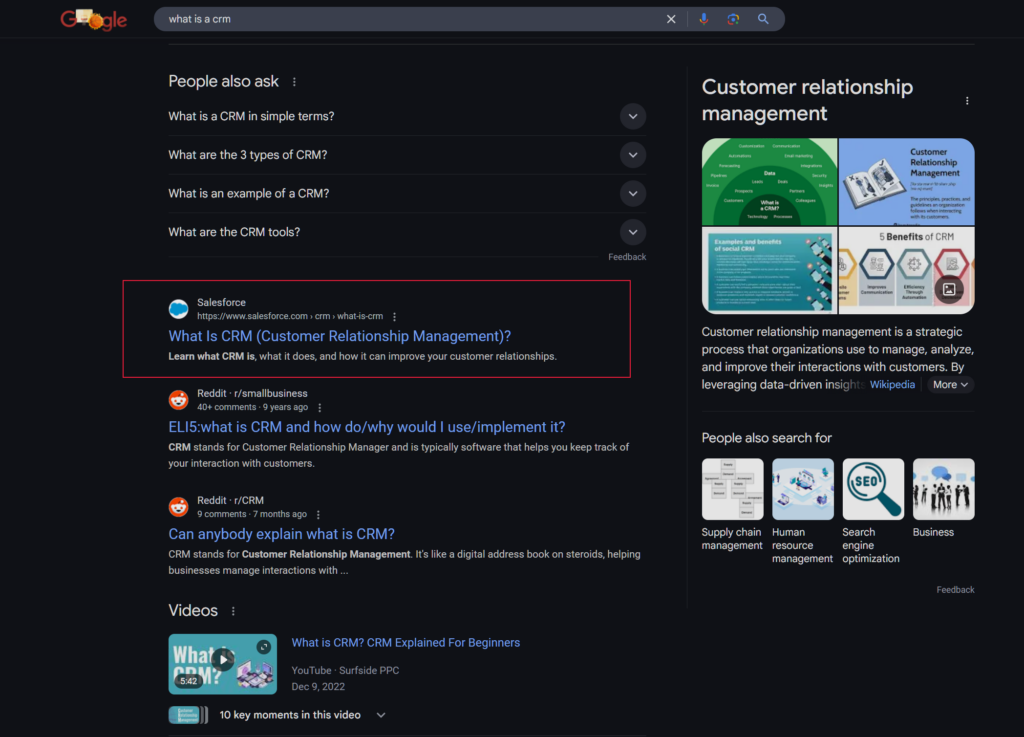
At some point, they optimized their content to specifically target the informational nature of the query. This alignment allowed them to finally achieve the ranking they missed before. (I can’t use them as a bad example anymore.)
Would Salesforce have preferred their homepage to rank for this query? Maybe. But that would never have happened—it just didn’t align with Google’s interpretation of user intent. And that is the point of this entire article.
Optimizing for user intent is one of the smartest SEO approaches today. Search engines like Google are intent matchmakers. When your content aligns with what users seek, you’re rewarded with higher rankings, happier visitors, and more conversions.
In this article, we’ll break down the different types of search intent and explain how catering to each can boost your SEO.
What Is User Intent (and Why It Matters)?
User intent (or search intent) is the expected result a user has in mind when typing a query into a search engine. In other words, it’s the web pages the searcher wants after searching for a keyword or keyphrase.
For example, someone searching for “best guitar strings” is likely looking to compare options, whereas “buy D’Addario NYXL 10-46 gauge strings” signals that they’re ready to purchase.
Google has become adept at interpreting these intentions – their documentation notes that “to return relevant results, we first need to establish what you’re looking for – the intent behind your query.” (source: Search Quality Evaluators Guidelines)
Aligning your content with user intent isn’t just an SEO box to tick – it’s the backbone of a successful content strategy. When your pages deliver precisely what the searcher needs:
- Rankings improve: Google prioritizes relevant results. Pages that best fulfill the search intent are far more likely to reach the top positions. Conversely, even high-quality content can languish on page 2 (or deeper) if it doesn’t match what users seek.
- Engagement soars: When your page satisfies their query, visitors stick around longer, consume more content, and “pogo-stick” (bounce back to search results) less. Meeting intent means users find value immediately, which builds trust.
- Conversions increase: By guiding users with the right content at the right stage of their journey, you move them naturally toward conversion. More qualified traffic and better user experience ultimately lead to higher conversion rates.
The bottom line is that if your content pleases searchers, Google will reward you with the rankings you want.
The Four Types of Search Intent
Nearly all searches fall into four intent categories. Understanding these will help you craft content that aligns with what users are looking for:
1. Informational Intent
When a user’s intent is informational, they want to learn something or get an answer to a question. These are often early-stage, curiosity-driven queries. Searchers tend to use question words like “what,” “how,” “who,” “why,” etc.
For example: “What is a humbucker?” or “How to play guitar faster?”
- What they want: Knowledge, insights, or solutions. They’re not ready to buy; they’re educating themselves. They are still at the top of the funnel, which corresponds to the awareness stage of the buyer’s journey.
- How it shows up on SERPs: Google often serves rich informational results. Expect “People Also Ask” questions, knowledge panels, images or videos, and very few (if any) product ads. For instance, a query like “How do solar panels work?” might trigger an in-depth snippet or a Wikipedia panel. Informational SERPs are not usually commercial. Google knows the searcher is not looking to buy right now, just looking to learn.
- Content to create if your keyword is competing in an Informational SERP: High-value educational content, plain and simple. Blog posts, how-to guides, tutorials, infographics, and videos work well. Aim to answer the specific questions users have. Use clear headings, including definitions, step-by-step instructions, or quick answers. Establish your brand as a helpful expert.
- Example: A search for “how to invest in stocks” will likely surface beginner’s guides from finance sites, explainer videos, and maybe a snippet outlining basic steps. Over time, that informational page can gently funnel readers to sign up for a newsletter or download a guide – a micro-conversion aligning with their interests.
2. Navigational Intent
Navigational queries occur when the user wants to go to a specific website or page and already has a destination in mind.
In a sense, they’re using Google like a shortcut or GPS. For example: searching “Facebook login”, “NYTimes subscription page”, or just a brand name like “Spotify” or “CNN”.
- What they want: A particular site or page. Often, it’s a brand’s homepage, login page, or a known resource. This indicates strong brand recognition or a user returning to a site.
- How it shows up on SERPs: Google will almost always put the official site at the top. You’ll often see sitelinks (the indented sub-links to essential pages of that site) and maybe a search box for the website within the result. If it’s a well-known brand or entity, a knowledge panel might be on the side (for example, a panel with company info or social profiles). Essentially, the SERP steers the user straight to the intended destination with minimal distractions.
- Content to create if your keyword is competing in a navigational SERP: If you are the target site, make sure your homepage and key pages have clear titles and meta tags so Google recognizes them. This helps them understand the purpose of each page. Implement organizational schema markup to help encourage sitelinks and a search box. Ensure your brand’s SEO is solid (you want to own your navigational queries!).
If you’re not the intended site, there’s little value in ranking for these – the user already knows where they want to go. Instead, focus on being visible when the user is still undecided (informational or commercial queries). - Example: A search for “Slack pricing” is navigational—the user likely wants Slack’s pricing page. That’s it.
3. Commercial Intent
Also known as the commercial investigation phase, this intent concerns researching before a purchase. The user is interested in buying something (or signing up for a service) but is in the comparison/consideration stage.
The searcher is weighing options, reading reviews, and seeking the best choice available. Common keywords include “best,” “top 10,” “reviews,” “compare,” or adding qualifiers like “…for beginners” or “…vs …”
- What they want: To evaluate products or services. Essentially, to be persuaded with evidence. They’re building a case for what to buy. This is mid-funnel intent: the user is interested but has not yet decided.
- How it shows up on SERPs: Google often serves up comparative content. You’ll see listicles and review sites (e.g., “Best electric guitars in 2025”) rather than a single product page. There may also be star ratings in results (from review schema), videos (e.g., “X product review” on YouTube), and sometimes shopping or product carousels if Google detects high purchase intent. For example, “best DSLR camera” might yield blog rankings of top cameras, while “X vs Y” shows comparison articles. These SERPs can be a mix of informational and transactional signals – e.g., ads or shopping results might appear alongside organic comparisons, indicating a blend of intent.
- Content to create if your keyword is competing in a commercial SERP: Comparison and decision-making content works great. Think product roundups, product vs product comparisons, detailed reviews, case studies, testimonials, and buying guides. This content should educate and sell simultaneously, providing unbiased information but highlighting what makes your product/service stand out. Use headings, pros/cons lists, tables, and visuals to help readers scan and evaluate options. If possible, incorporate user reviews or data. Also, consider SEO elements like review schema for star ratings to enhance your snippet. Your goal is to be the trusted advisor that helps the user decide – and, naturally, to recommend your solution if it fits.
- Example: Search for “best project management software,” and you’ll likely see articles from tech blogs or sites like PCMag listing top tools rather than any single software company’s homepage. If your company sells a project management tool, you’d want to be featured in those lists or create your comparison content (e.g., a comprehensive guide comparing the top tools, including yours). Another example is “Tesla vs BMW electric car.” A user wants a comparison, so a smart content strategy for an auto blog or dealership might be a detailed comparison page that captures that traffic.
4. Transactional Intent
When intent is transactional, the user is ready to DO something – usually to make a purchase or take a specific action. This is the bottom-of-funnel, high-intent query. Keywords often include “buy,” “order,” “download,” “coupon,” or specific product names/models (often with words like “price” or “deal”). Local searches like “<product> near me” or “<service> in <city>” also fall here – the user intends to take action now.
- What they want: To convert immediately. This could mean completing an e-commerce purchase, signing up for a trial, contacting sales, or visiting a local store. They’ve done the research; now they’re pulling the trigger.
- How it shows up on SERPs: Google loads these results with transaction-focused features. Expect to see Google Ads at the top, Shopping ads or product carousels (with images and prices of items), and if it’s a local intent (like “tacos near me” or “plumber in Dallas”), a local pack with map and listings. Organic results will skew toward product or category pages on e-commerce and official sites. For instance, someone searching “Buy iPhone 14 online” will see Apple or retailer ads, a product carousel of iPhone models, and organic links to retailers’ product pages. A search for a specific branded product (navigational + transactional) like “Adobe Photoshop download” will take you directly to Adobe’s download page with sitelinks. In short, the SERP is geared to get the user to a point-of-sale or conversion ASAP.
- Content to create if your keyword is competing in a transactional SERP: High-conversion landing pages. This includes product pages, signup pages, pricing pages, etc., optimized for usability and conversions. Key elements: clear calls-to-action (CTA), prominent “Add to cart” or “Contact us” buttons, trust signals (reviews, security badges), and all the info a buyer needs (specs, pricing, FAQs). For local transactional searches, ensure your Google My Business listing and local SEO are in order (so you appear in map packs). Also, consider offering something extra that competitors might not – free shipping, a demo video, or a limited-time offer – to capture the ready-to-act user.
- Example: An ideal landing page for “men’s white running shoes size 10 buy online” is a filtered e-commerce category or product page showing white running shoes in size 10 with a “Buy Now” option. If your site sells this, you’d want that exact page SEO-optimized. Another example: “Acme Software pricing” – ensure the user lands on a clean pricing page with a clear signup button. These users have intent to give you their money or info; make it as easy as possible for them to do so.
Note: A single query can sometimes span multiple intent types, which Google handles by showing a mix of results. For instance, the query “best air fryer” has elements of informational, commercial, and transactional.
The SERP reflects this with product review articles, basic info about air fryers, and shopping ads together. We call this a mixed-intent result page.
Identifying User Intent (Tools & Tactics)
How do you determine what intent category a given keyword or topic falls into? It’s part art, part science – but there are some reliable methods and tools:
Study the SERPs
The simplest and most crucial step is to Google the keyword. Then, examine what types of pages and features are on page one.
Are you seeing informational results (wiki, how-tos), lots of ads, specific brands? This is your strongest hint to Google’s interpretation of intent. As Brian Dean of Backlinko puts it, “The pages on the first page have obviously passed Google’s user intent test… So you want to create a page that closely matches what you find on page 1.”
In other words, let the existing top Google results inform your strategy. If all the top results for “investment tips” are blog articles, you probably shouldn’t target it with a product page. If you see a mix of intent (e.g., some blogs, some product pages), your content might need to cover multiple angles, or you may choose which intent to focus on and do it better than anyone.
While checking SERPs, note the language and format of titles/descriptions:
- Do they mostly start with “How to…” or “What is…”? That screams informational.
- Do you see words like “Buy,” “Price,” “Deal”? Clearly transactional.
- Words like “Best,” “Top,” or year numbers (e.g., “Best X in 2025”) indicate comparison content – commercial intent.
- A lot of branded homepage results? Navigational intent is likely.
Additionally, look at related searches or Google Autocomplete suggestions – they often hint at what users mean.
Use Keyword Research Tools with Intent Data
Manual analysis is great but challenging at scale (hundreds of keywords). SEO tools can assist by labeling keywords with a likely intent. For example, Ahrefs Keywords Explorer categorizes intent for you. Ahrefs uses AI to identify dominant intent:

There are also tools like Semrush, which, in their Keyword Magic tool, assign intent labels and shows SERP features present:
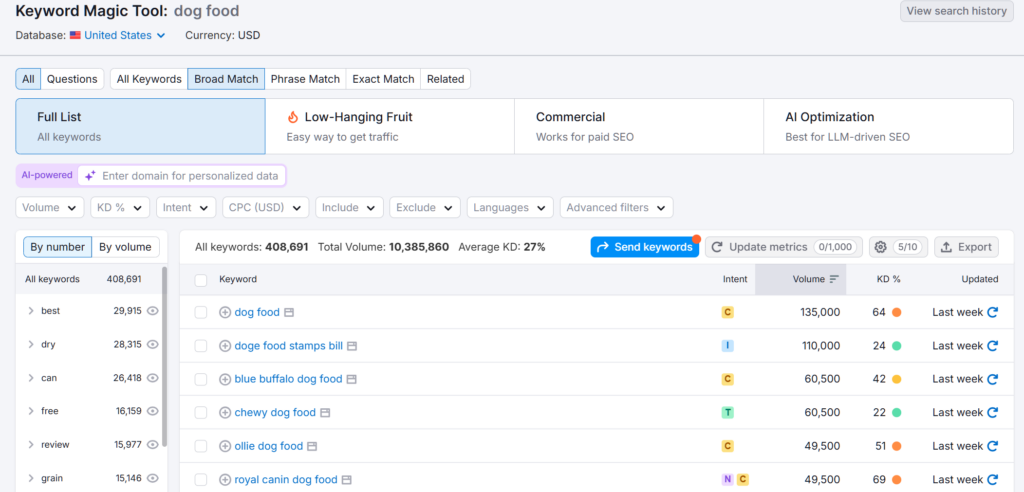
Analyze Query Language and Modifiers
Train your team to recognize intent signals in the keywords themselves. Some quick clues:
- Informational – question words (what, how, why), general topic terms (“history of…”, “guide to…”, “tips for…”).
- Navigational – brand or product names, website names, URL fragments, or app names.
- Commercial – “best,” “top,” “reviews,” “comparison,” “alternative to,” “versus/vs,” and sometimes adjectives (“affordable X”, “fastest Y”).
- Transactional – “buy,” “order,” “price,” “coupon,” “discount,” “near me,” “shipping,” or very specific product models (indicating the person knows exactly what they want).
Context matters, too. A single word like “Apple” could be informational (if the person wants nutrition info on the fruit), navigational (if they meant Apple Inc.), or transactional (if they intended to go to the Apple online store). That’s why looking at the surrounding words or simply Googling it to see context is key.
Advanced Strategies: Content Clusters, Internal Links & Conversion Paths
To dominate SEO with an intent-based approach, think bigger than single pages. You need a strategy for your entire content ecosystem that guides users from their first query to final conversion. This is where content clusters, smart internal linking, and designed conversion paths come in.
Build Content Clusters Around User Intent
Rather than creating standalone pages that each target one keyword, a modern SEO approach is to build topic clusters. A content cluster centers on a broad “pillar” topic and includes multiple sub-pages that delve into specific aspects of that topic.
This helps with SEO (covering a topic comprehensively signals authority) and naturally covers multiple user intents in one fell swoop.
For example, suppose you’re an executive at a project management SaaS company. A pillar page might be “Project Management 101: Ultimate Guide to Managing Projects.” This is a long, authoritative overview targeting mostly informational intent (awareness stage). Then, you create cluster pages like:
- “What is Project Management?” (definition – informational)
- “How to Choose a Project Management Software” (commercial intent – comparing solutions)
- “Project Management Software vs. Spreadsheets” (commercial/comparative)
- “Project Management Software Pricing Guide” (commercial/transactional mix)
- “Project Management Case Study: [Client]” (commercial proof)
- “Sign Up for [Your Software] – Free Trial” (transactional)
All these cluster pages interlink with the pillar and with each other where relevant. The pillar links out to them (for deeper dives on subtopics), and they link back to the pillar (strengthening the hub).
In other words, a well-designed cluster can capture a user searching a basic question, educate them, show them comparisons, and finally present the solution (your product) in a logical sequence. It addresses user intent from awareness to purchase.
Use Internal Linking as an Intent Pathway
Think of internal links as guided pathways for user intent. Every link from one piece of content to another should be a helpful nudge deeper into the funnel (when appropriate). Some best practices:
- Link from informational to commercial pages: Once you’ve answered a user’s initial question, invite them to explore further. For instance, a blog post about the “benefits of cloud storage” (informational) can naturally mention “when choosing a provider, you should compare options” and link to a “Top 5 Cloud Storage Solutions” page (commercial). Similarly, that comparison page can link to “Get a free trial of [Your Solution]” (transactional).
- Link laterally for thoroughness: Within a cluster, you might link between informational pages as well (e.g., “What is X?” page linking to “How X works” page) to ensure the curious reader can easily find all related info. This keeps them on your site instead of returning to Google for each new question. Those are good user metrics!
- Use descriptive anchor text indicating the next intent: Instead of “click here,” write something like “See our expert comparison of top tools.” It tells the user (and Google) that the next page serves a comparative intent. This semantic signal can reinforce the topical relationship.
- Consider conversion in your link structure: One advanced technique is mapping out your internal links to mirror the conversion funnel. For example, all your top-of-funnel pages link to at least one mid-funnel resource. All mid-funnel pages link to bottom-of-funnel pages or conversion points. And bottom-funnel pages may link back out to supporting content (for those who need more info before converting). This intentional linking is almost like designing user journeys.
From an SEO perspective, internal links also distribute “link equity” throughout the site, boosting the visibility of important pages. If your pillar page gets tons of backlinks (due to being a great resource), those internal links also funnel some authority to your product pages, indirectly helping their rankings.
Design Conversion Paths for Each Intent Stage
A conversion path is a user’s route from first visiting your site to taking a desired action (purchase, sign-up, etc.). By aligning conversion paths with search intent, you essentially meet the user where they are and gently walk them toward becoming a customer. Here’s how to do it:
- Map content to the buyer’s journey: For each intent type, decide what the conversion goal is. For informational content, the conversion might simply be getting the user’s email (e.g., “Subscribe for more tips” or downloading a free e-book) – something low commitment since they’re not ready to buy yet. For commercial intent content, the conversion goal could be a product demo request or adding a product to the cart. For transactional pages, the goal is obviously purchase or sign-up. By defining these goals, you can place appropriate calls to action on each page that feels natural to the user’s intent.
- Use progressive calls-to-action: Don’t jump the gun on a user who’s not ready. For instance, on a purely informational blog post, a giant “Buy Now!” banner will likely be ignored (or worse, annoy the reader). Instead, a softer CTA like “Enjoying this guide? Sign up to our newsletter for more insights” is more fitting. On the flip side, on a product page, it’s appropriate to have “Start Free Trial” or “Contact Sales” loud and clear. Tailor the ask to the intent.
- Cross-link your CTAs: A user might enter at mid-funnel and realize they need more basic knowledge. Your commercial page could have a subtle “New to this topic? Read our beginner’s guide” link – that’s a reverse conversion path (downshifting intent), but it can be necessary. Ultimately, a well-designed site lets users move up or down the funnel easily: awareness <-> consideration <-> decision stages.
- Track and refine: Use analytics and user flow tools to see how people navigate. If you notice that a high percentage of users who read an informational article, then click to a comparison page and then to a product page have a high conversion rate, that’s validation of your intent funnel. If not, see where they drop off—maybe the comparison didn’t compel them, or the product page was missing information. Optimize accordingly.
Bring It All Together
To wrap up, aligning with user intent is not a one-time tweak but a holistic approach to SEO and content marketing. You research what your audience seeks at each stage, create content to meet those needs, and knit that content together into a cohesive experience that nudges users along. The payoff? Search engines see your relevance and authority (better rankings!), users find precisely what they need (better engagement!), and you seamlessly guide them to your business outcomes (better conversions!).
Optimizing for intent transforms your website from a random collection of pages into a well-oiled funnel that captures and converts organic traffic. It’s smart, strategic, and – dare we say – a bit fun to watch in action (there’s nothing like seeing those conversion graphs trend up after implementing an intent-driven strategy).
User intent is the secret sauce that turns SEO from a hit-or-miss game of keywords into a purposeful strategy. By understanding the intent behind queries and crafting content to match, you do more than please an algorithm – you please your audience. Google’s mission is to organize the world’s information and make it useful; when your content is the most useful for a given intent, you’ve essentially aligned your goals with Google’s and your customers’.


